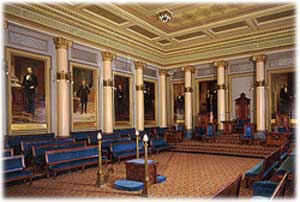

|
Ionic Hall | |
| The Ionic Order of architecture received its name from
Ionia, where King Ion reigned in Asia Minor. Ionians were mostly Greek
emigrants. Refinement and elegance are the characteristics of Ionic style.
The pillars of this Hall, decorated in 1890, are finished in cream-tone ivory and their capitals are enriched with gold, vermilion and blue. The wall panels contain full-length portraits of Right Worshipful Past Grand Masters: Joseph Eichbaum, Peter Fritz, Conrad B. Day, Peter Williamson, John Thomson, Robert Clark, William Barger, George E. Wagner, Michael Arnold, Henry W Williams, Richard Vaux, Robert A. Lamberton, and Clifford P. MacCalla. Otherwise the walls are a delicate blue. | |
|
The ceiling of Ionic Hall represents the blue vault of heaven. In the center blazes the midday sun, surrounded by the planetary and zodiacal signs. The twelve signs of the zodiac represent the twelve portions of the heavens through which the sun courses during the year. Inscribed clay Assyrian cylinders indicate an antiquity of at least four thousand years for these signs of the zodiac. The most ancient known depiction is on a fragment of a Chaldean planisphere in the British Museum inscribed with the names of the twelve months and their governing signs. Zodiac, derived from Greek zodion, means "little animal." | |
I onic Hall is sixty-four feet long, forty-one feet wide and twenty-one feet high. Click
here for a complete tour of The Masonic Temple in Philadelphia | |